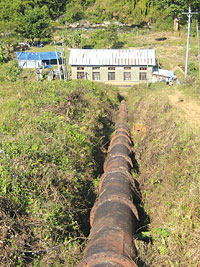|
|
Nepal has lots of potential for small hydropower schemes. But there isn't enough money to run proper schools and colleges in rural areas.
So what can be done? Why not sell electricity to fund higher education?
It's a simple power-for-education formula that is being successfully implemented in Nepal's eastern district of Sankhuwasabha by the private company Samudayik Sikhsa Bikash Jalbiddut, which means \'community education through electricity\'.
"It's such a simple idea, we often wonder why we didn't think of it before," says Hari Bairagi, the former UML member of parliament from the district. "Everyone knows you need education for development, but we have turned that around. We are using development to finance education."
The 250-megawatt Nigure micro-hydropower scheme was built 20 years ago during the Panchayat regime as part of the government's mission to light up the district headquarters. In 2002 the station was blown up by the Maoists and for more than a year it lay in ruins. In April 2003 three local colleges - Barun Multiple Campus, Madi Multiple Campus and Chainpur Multiple Campus - linked up to revive the power station with a loan of Rs 10.8 million and assistance from German aid agency GTZ and energy group Winrock. Experts say the power plant can easily double its capacity and increase income.
Tulsi Prasad Neupane, the company\'s president, says: "It's really working well. We sell electricity to the NEA grid and with the money run the colleges."
In 17 months, the company has already generated Rs 3.9 million in cash from the NEA. There are still loans to be paid off, but the colleges already have a revenue stream for scholarships for needy students and to pay teachers\' salaries.
"Most of the families here are poor. They can't afford school fees, so the scholarship fund means a lot to the community and for our college," says Parsuram Dahal, principal of Madi Multiple Campus. All three colleges plan to invest more on increasing student capacity as they earn more profit.
Economist and former water resources minister Dipak Gyawali says the Sankhuwasabha example has turned development in its head. "In previous development models, revenue flowed from the village to the centre. This is an excellent example of how villages earn from the centre."
 |
"There cannot be a better source of long term income for institutes like colleges, hospitals and others," says Hari Bairagi Dahal. "Water is the raw material, no transport is required, and the national grid is right there to buy the product. All you need is initiative." Dahal thinks the model works best locally, but could also be the way to go nationally, with income from hydro power generation funding a nationwide upgrading of education and health facilities.
The Sankhuwasabha model is an example of how a ruined hydropower scheme can rise from the ashes of war to improve people's lives in peacetime, but it is not yet crisis-free.
Having once bombed the power plant during the conflict, local YCL cadres are now using extortion to demand a \'revolutionary tax\' of 25 per cent of the profit that should be funding the colleges.
Last year the Maoists locked the power house for a week, but it was reopened after teachers and students from the three colleges retaliated by locking the Maoist office in Khandbari. Negotiations are still continuing.



